1995 GMC SIERRA low oil pressure
[x] Cancel search: low oil pressurePage 77 of 488
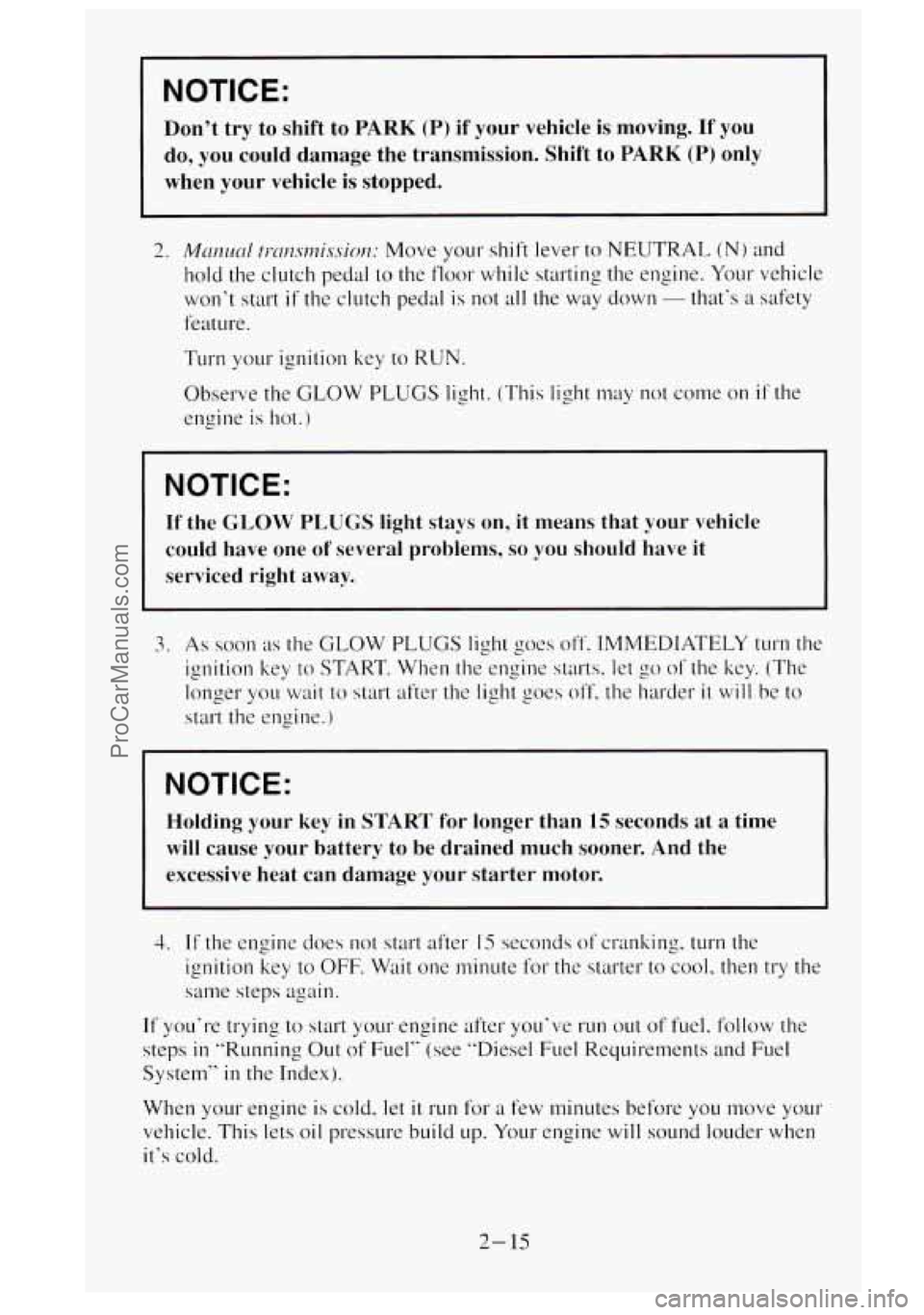
NOTICE:
Don't try to shift to PARK (P) if your vehicle is moving. If you
do, you could damage the transmission. Shift to
PARK (P) only
when your vehicle is stopped.
2. MmLwl ~I-~~CZ.SI~~~.YS~~CZ: Move your shift lever to NEUTRAL (N) and
hold the clutch pedal
to the floor while starting the engine. Your vehicle
won't start
if the clutch pedal is not all the wlay down - that's a safety
feature.
Turn your ignition key to
RUN.
Observe the GLOW PLUGS light. (This light may not come on if the
engine is hot.)
NOTICE:
If the GLOW PLUGS light stays on, it means that your vehicle
could have one
of several problems, so you should have it
serviced right away.
3. As soon as the GLOW PLUGS light goes off. IMMEDIATELY turn the
ignition key
to START. When the engine starts. let go of the key. (The
longer you wait to start after the light goes
off, the harder it will be to
start the engine.)
NOTICE:
Holding your key in START for longer than 15 seconds at a time
will cause your battery to
be drained much sooner. And the
excessive heat can damage your starter motor.
4. If the engine does not start after IS seconds of cranking. turn the
ignition key to OFF. Wait one minute
for the starter to cool. then try the
same steps again.
If you're trying to start your engine after you've run out of fuel. follocv the
steps
in "Running Out of Fuel" (see "Diesel Fuel Requirements and Fuel
System"
in the Index).
When
YOLI~ engine is cold. let it run for a few minutes before you move your
vehicle. This lets oil pressure build
up. Your engine will sound louder when
it's cold.
2- 15
ProCarManuals.com
Page 143 of 488
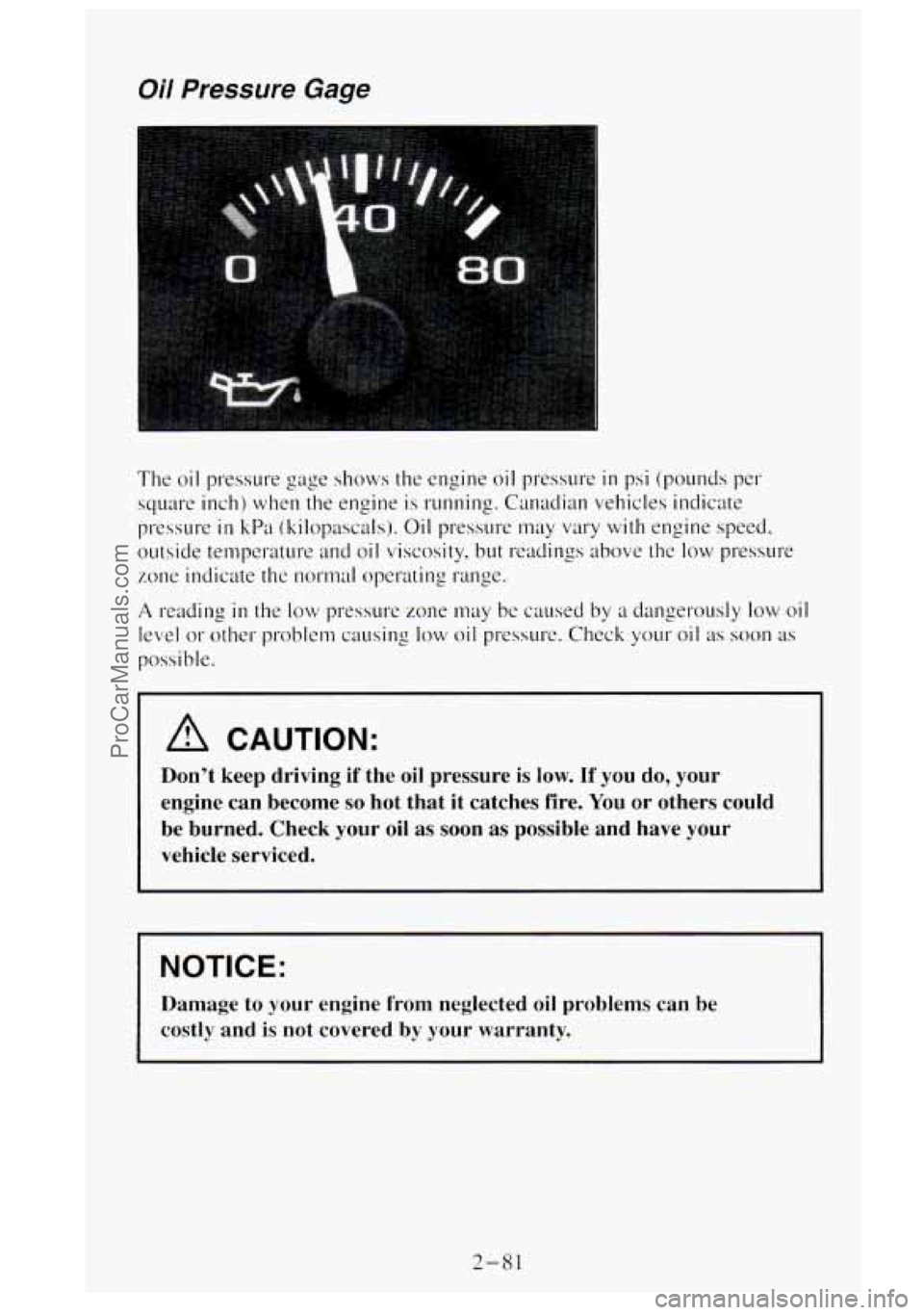
Oil Pressure Gage
The oil pressure gage shows the engine oil pressure in psi (pounds per
square inch) when the engine is running. Canadian vehicles indicate
pressure
in kPa (kilopascals). Oil pressure may vary with engine speed,
outside temperature and oil viscosity, but readings above the
low pressure
zone indicate the norn~al opcrating ranse.
A reading in the low pressure zone may bc caused by a dangemusly low oil
level or other problem causing low oil pressure. Check your oil as soon as
possible.
A CAUTION:
Don’t keep driving if the oil pressure is low. If you do, your
engine can become
so hot that it catches fire. You or others could
be burned. Check your oil
as soon as possible and have your
vehicle serviced.
NOTICE:
Damage to your engine from neglected oil problems can be
costly and is not covered by your warranty.
2-81
ProCarManuals.com
Page 202 of 488
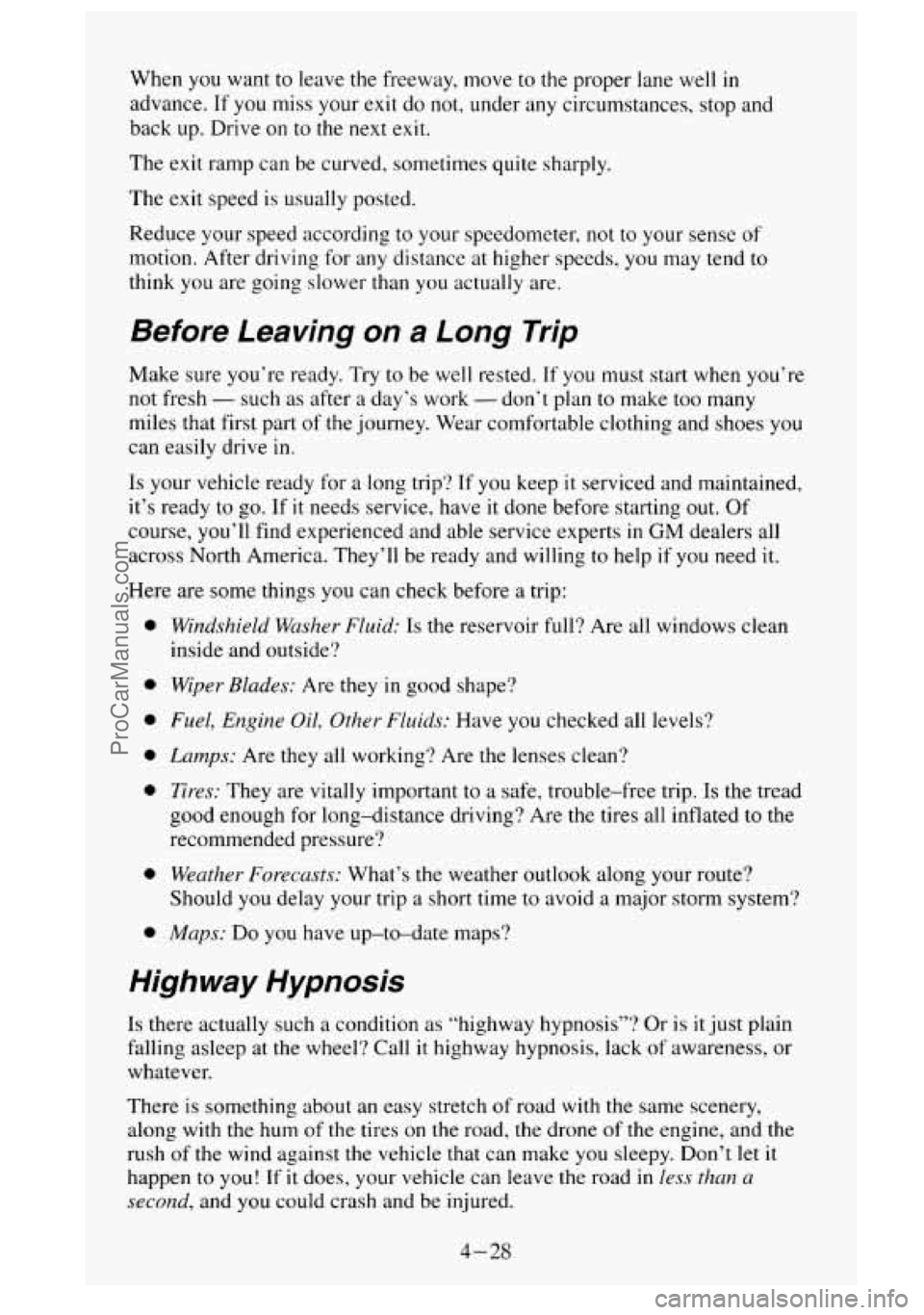
When you want to leave the freeway, move to the proper lane well in
advance. If
you miss your exit do not, under any circumstances, stop and
back up. Drive on
to the next exit.
The exit ramp can be curved, sometimes quite sharply.
The
exit speed is usually posted.
Reduce your speed according to your speedometer, not to your sense
of
motion. After driving for any distance at higher speeds, you may tend to
think you are going slower than you actually are.
Before Leaving on a Long Trip
Make sure you’re ready. Try to be well rested. If you must start when you’re
not fresh
- such as after a day’s work - don’t plan to make too many
miles that first part
of the journey. Wear comfortable clothing and shoes you
can easily drive
in.
Is your vehicle ready for a long trip‘? If you keep it serviced and maintained,
it’s ready to go.
If it needs service, have it done before starting out. Of
course, you’ll find experienced and able service experts
in GM dealers all
across North America. They’ll be ready and willing to help if you need it.
Here are some things you can check before a trip:
0
0
0
0
0
a
0
Windshield Washer Fluid: Is the reservoir full? Are all windows clean
inside and outside?
Wiper Blades: Are they in good shape?
FueZ, Engine Oil, Other Fluids: Have you checked all levels?
Lamps: Are they all working? Are the lenses clean?
Tires: They are vitally important to a safe, trouble-free trip. Is the tread
good enough for long-distance driving? Are
the tires all inflated to the
recommended pressure?
Weather Forecasts: What’s the weather outlook along your route?
Should
you delay your trip a short time to avoid a major storm system?
Maps: Do you have up-to-date maps?
Highway Hypnosis
Is there actually such a condition as “highway hypnosis”? Or is it just plain
falling asleep at the wheel? Call it highway hypnosis, lack of awareness, or
whatever.
There
is something about an easy stretch of road with the same scenery,
along with the
hum of the tires on the road, the drone of the engine, and the
rush
of the wind against the vehicle that can make you sleepy. Don’t let it
happen
to you! If it does, your vehicle can leave the road in less than a
second, and you could crash and be injured.
4-28
ProCarManuals.com
Page 245 of 488
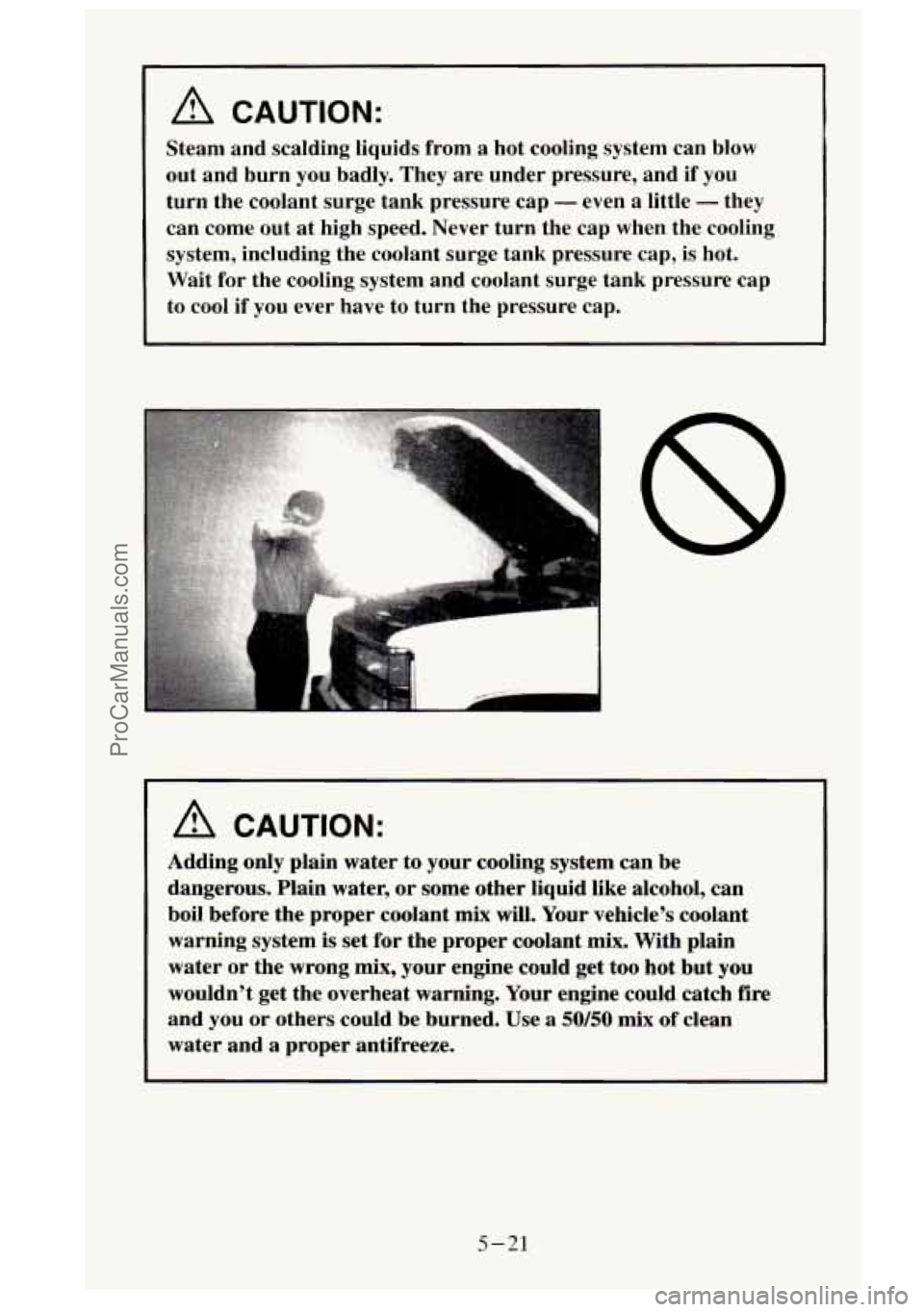
A CAUTION:
Steam and scalding liquids from a hot cooling system can blow
out and burn you badly. They are under pressure, and
if you
turn the coolant surge tank pressure cap
- even a little - they
can come out at high speed. Never turn the cap when the cooling
system, including the coolant surge tank pressure cap,
is hot.
’ Wait for the cooling system and coolant surge tank pressure cap
to cool
if you ever have to turn the pressure cap.
A CAUTION:
Adding only plain water to your cooling system can be
dangerous. Plain water, or some other liquid like alcohol, can
boil before the proper coolant mix
will. Your vehicle’s coolant
warning system is set for the proper coolant mix. With plain
water
or the wrong mix, your engine could get too hot but you
wouldn’t get the overheat warning. Your engine could catch fire
and you or others could be burned. Use
a 50/50 mix of clean
water and a proper antifreeze.
5-21
ProCarManuals.com
Page 335 of 488
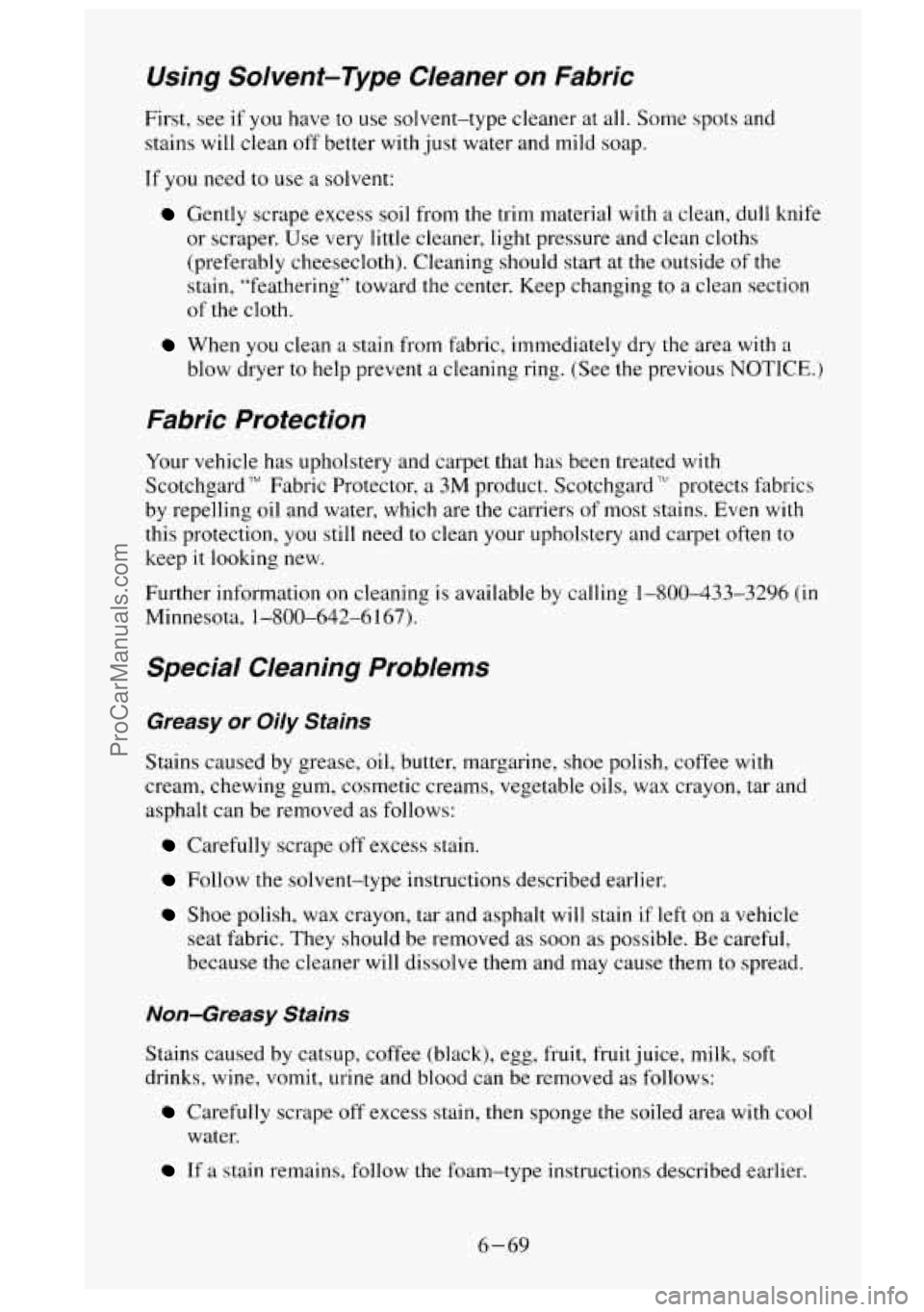
Using Solvent-Type Cleaner on Fabric
First, see if you have to use solvent-type cleaner at all. Some spots and
stains will clean
off better with just water and mild soap.
If you need to use a solvent:
Gently scrape excess soil from the trim material with a clean, dull knife
or scraper. Use very little cleaner, light pressure and clean cloths
(preferably cheesecloth). Cleaning should start at the outside of the
stain, “feathering” toward the center. Keep changing to
a clean section
of the cloth.
When you clean a stain from fabric, immediately dry the area with a
blow dryer to help prevent a cleaning ring. (See the previous NOTICE.)
Fabric Protection
Your vehicle has upholstery and carpet that has been treated with
Scotchgard TM Fabric Protector, a 3M product. Scotchgard TN protects fabrics
by repelling oil and water, which are the carriers of most stains. Even with
this protection, you still need to clean your upholstery and carpet often to
keep
it looking new.
Further information
on cleaning is available by calling 1-800-433-3296 (in
Minnesota, 1-800-642-6 167).
Special Cleaning Problems
Greasy or Oily Stains
Stains caused by grease, oil, butter, margarine, shoe polish, coffee with
cream, chewing gum, cosmetic creams, vegetable oils, wax crayon, tar and
asphalt can be removed as follows:
Carefully scrape off excess stain.
Follow the solvent-type instructions described earlier.
Shoe polish, wax crayon, tar and asphalt will stain if left on a vehicle
seat fabric. They should be removed as soon
as possible. Be careful,
because the cleaner will dissolve them and may cause them to spread.
Non-Greasy Stains
Stains caused by catsup, coffee (black), egg, fruit, fruit juice, milk, soft
drinks, wine, vomit, urine and blood can be removed as follows:
Carefully scrape off excess stain, then sponge the soiled area with cool
water.
If a stain remains. follow the foam-type instructions described earlier.
6-69
ProCarManuals.com
Page 338 of 488
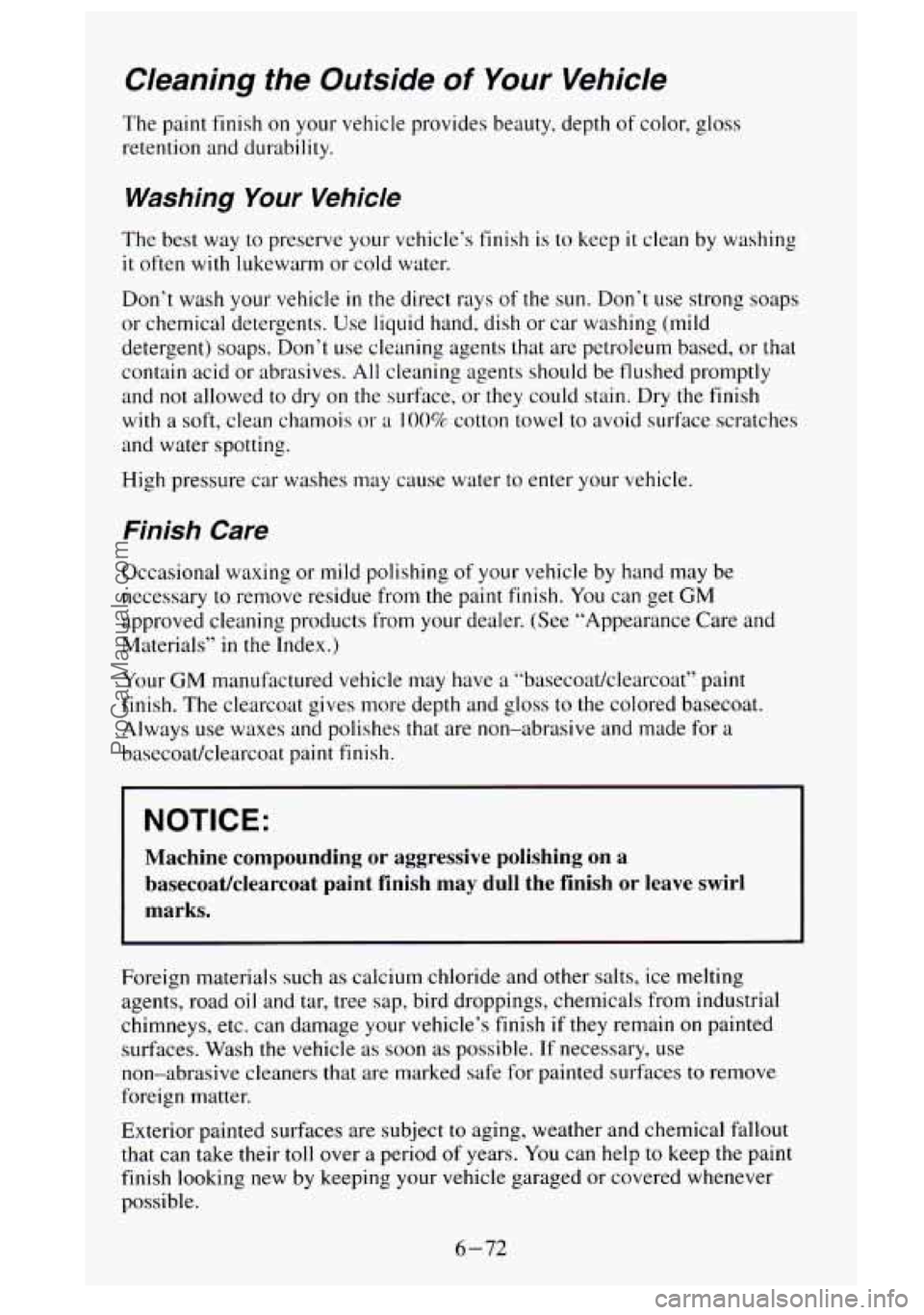
Cleaning the Outside of Your Vehicle
The paint finish on your vehicle provides beauty, depth of color, gloss
retention and durability.
Washing Your Vehicle
The best way to preserve your vehicle’s finish is to keep it clean by washing
it often with lukewarm or cold water.
Don’t wash your vehicle
in the direct rays of the sun. Don’t use strong soaps
or chemical detergents. Use liquid hand, dish or car washing (mild
detergent) soaps. Don’t use cleaning agents that are petroleum based, or that
contain acid or abrasives. All cleaning agents should be flushed promptly
and
not allowed to dry on the surface, or they could stain. Dry the finish
with a soft, clean chamois
or a 100% cotton towel to avoid surface scratches
and water spotting.
High pressure car washes may cause water to enter your vehicle.
Finish Care
Occasional waxing or mild polishing of your vehicle by hand may be
necessary
to remove residue from the paint finish. You can get GM
approved cleaning products from your dealer. (See “Appearance Care and
Materials” in the Index.)
Your
GM manufactured vehicle may have a ‘‘base~~at/~learcoat” paint
finish. The clearcoat gives more depth and gloss to the colored basecoat.
Always use waxes and polishes that are non-abrasive and made for a
basecoatklearcoat paint finish.
NOTICE:
Machine compounding or aggressive polishing on a
basecoatlclearcoat paint finish may dull the finish
or leave swirl
marks.
Foreign materials such as calcium chloride and other salts, ice melting
agents, road oil and tar, tree
sap, bird droppings, chemicals from industrial
chimneys, etc. can damage your vehicle’s
finish if they remain on painted
surfaces. Wash the vehicle as soon as possible. If necessary, use
non-abrasive cleaners that are
marked safe for painted surfaces to remove
foreign matter.
Exterior painted surfaces are subject
to aging, weather and chemical fallout
that can take their
toll over a period of years. You can help to keep the paint
finish looking new by keeping your vehicle garaged or covered whenever
possible.
6-72
ProCarManuals.com
Page 367 of 488
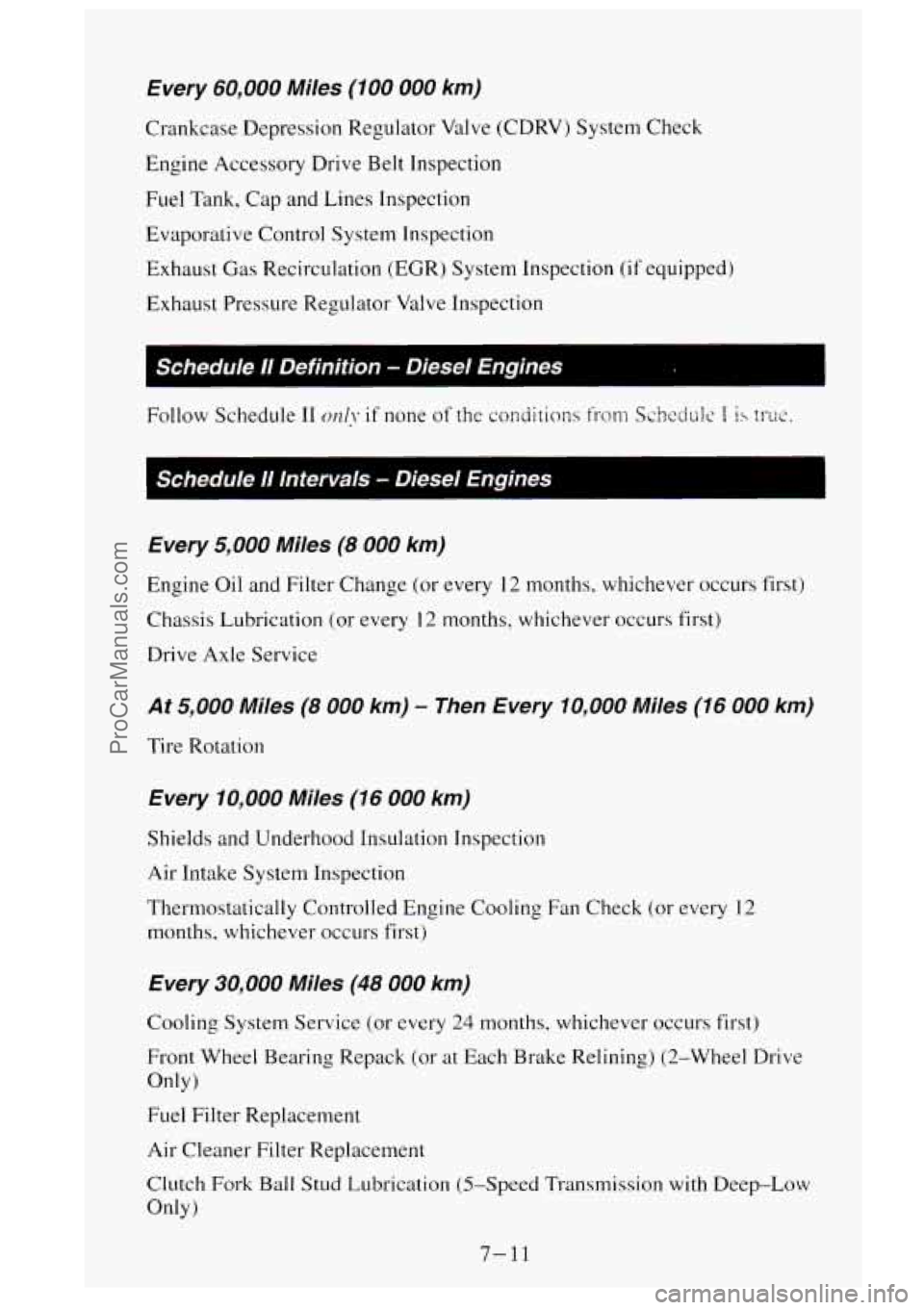
Every 60,000 Miles (100 000 km)
Crankcase Depression Regulator Valve (CDRV) System Check
Engine Accessory Drive Belt Inspection
Fuel Tank, Cap and Lines Inspection
Evaporative Control System Inspection
Exhaust Gas Recirculation (EGR) System Inspection
(if equipped)
Exhaust Pressure Regulator Valve Inspection
I Schedule 11 Definition - Diesel Engines
Follow Schedule II on!\- if none ofrhe conditions i'wm Schcdtilc I Is truc.
--
I Schedule I1 lntervals - Diesel Engines 1
Every 5,000 Miles (8 000 km)
Engine Oil and Filter Change (or every 12 months, whichever occurs first)
Chassis Lubrication
(or every 12 months, whichever occurs first)
Drive Axle Service
At 5,000 Miles (8 000 km) - Then Every 10,000 Miles (16 000 km)
Tire Rotation
Every 10,000 Miles (16 000 km)
Shields and Underhood insulation Inspection
Air Intake System Inspection
Thermostatically Controlled Engine Cooling Fan Check (or every
I2
months, whichever occurs first)
Every 30,000 Miles (48 000 km)
Cooling System Service (or every 24 months, whichever occurs first)
Front Wheel Bearing Repack (or
at Each Brake Relining) (2-Wheel Drive
Fuel Filter Replacement
Air Cleaner Filter Replacement
Clutch Fork Ball Stud Lubrication (5-Speed Transmission with Deep-Low
Only)
Only)
7-11
ProCarManuals.com
Page 441 of 488
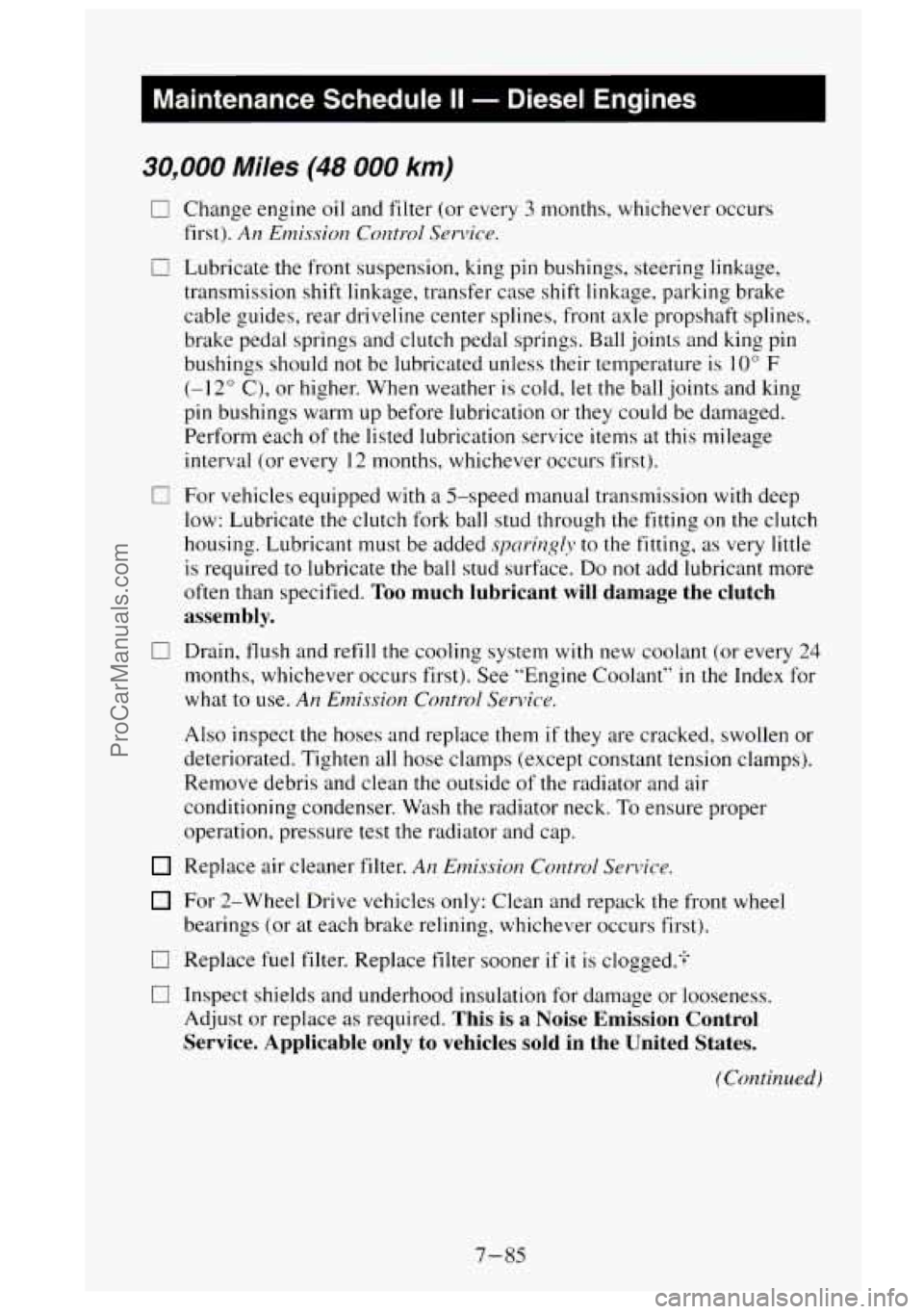
I Maintenance Schedule II - Diesel Engines
30,000 Miles (48 000 km)
0
0
0
Change engine oil and filter (or every 3 months, whichever occurs
first).
An Emission Control Service.
Lubricate the front suspension, king pin bushings, steering linkage,
transmission shift linkage, transfer case shift linkage, parking brake
cable guides, rear driveline center splines, front axle propshaft splines,
brake pedal springs and clutch pedal springs. Ball joints and king pin
bushings should not be lubricated unless their temperature is
10" F
(-12" C), or higher. When weather is cold, let the ball joints and king
pin bushings warm up before lubrication or they could be damaged.
Perform each of the listed lubrication service items at this mileage
interval (or every 12 months, whichever occurs first).
For vehicles equipped with a 5-speed manual transmission with deep
low: Lubricate the clutch fork ball stud through the fitting
on the clutch
housing. Lubricant must be added
spring1-y to the fitting, as very little
is required to lubricate the ball stud surface. Do not add lubricant more
often than specified.
Too much lubricant will damage the clutch
assembly.
Drain, flush and refill the cooling system with new coolant (or every 24
months, whichever occurs first). See "Engine Coolant" in the Index for
what to use.
An Ernission Control Service.
Also inspect the hoses and replace them if they are cracked, swollen or
deteriorated. Tighten all hose clamps (except constant tension clamps).
Remove debris and clean the outside of the radiator and air
conditioning condenser. Wash the radiator neck.
To ensure proper
operation, pressure test the radiator and cap.
Replace air cleaner filter.
An Emission Coratrol Service.
For 2-Wheel Drive vehicles only: Clean and repack the front wheel
bearings (or at each brake relining, whichever occurs first).
Replace fuel filter. Replace filter sooner
if it is clogged:?
Inspect shields and underhood insulation for damage or looseness.
Adjust
or replace as required. This is a Noise Emission Control
Service. Applicable only to vehicles sold in the United States.
(Continued)
7-85
ProCarManuals.com